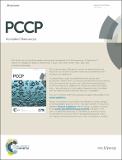Orientation selection in high-field RIDME and PELDOR experiments involving low-spin CoII ions
Date
28/01/2018Author
Grant ID
EP/R013705/1
099149/Z/12/Z
EP/F039034/1
Metadata
Show full item recordAbstract
Orientation selective (OS) RIDME and PELDOR were conducted on a low-spin CoII complex coordinated by two nitroxide (NO) labelled 2,2':6',2''-terpyridine ligands. Co-NO RIDME at W- and Q-band gave insight into the relative orientation between the Co-NO interspin vector (rCo-NO) and the NO moiety. This was further supported by W-band Co-NO PELDOR that also allowed elucidating the relative orientation of the CoII and NO g-tensors. Differences to earlier predictions were confirmed by DFT calculations. Finally, NO-NO PELDOR allowed retrieving the mutual orientations between the NO-NO interspin vector (rNO-NO) and the NO moieties. The results demonstrate that OS-RIDME and -PELDOR can provide geometric and electronic structure information on a system containing a CoII ion and two nitroxides. Especially, the high sensitivity and ease of interpretation of RIDME at W-band opens avenues for new applications of CoII as orthogonal spin label.
Citation
Giannoulis , A , Motion , C L , Oranges , M , Buehl , M , Smith , G M & Bode , B E 2018 , ' Orientation selection in high-field RIDME and PELDOR experiments involving low-spin Co II ions ' , Physical Chemistry Chemical Physics , vol. 20 , no. 4 , pp. 2151-2154 . https://doi.org/10.1039/C7CP07248A
Publication
Physical Chemistry Chemical Physics
Status
Peer reviewed
ISSN
1463-9076Type
Journal article
Description
AG and CLM were supported by postgraduate fellowships by the EPSRC-funded doctoral training centre ‘integrated magnetic resonance’. This work was supported by the European Union Seventh Framework Programme (PCIG12-GA-2012-334496). The W-band instrument was developed under the U.K. Research Councils Basic Technology Program (grant EP/F039034/1) and the Q-band equipment is supported by the Wellcome Trust (099149/Z/12/Z).Collections
Items in the St Andrews Research Repository are protected by copyright, with all rights reserved, unless otherwise indicated.

